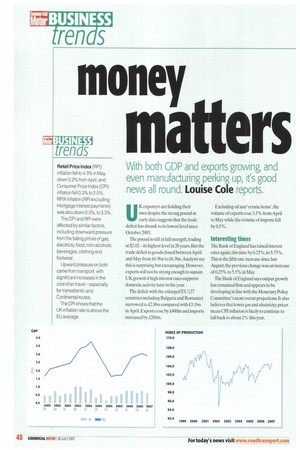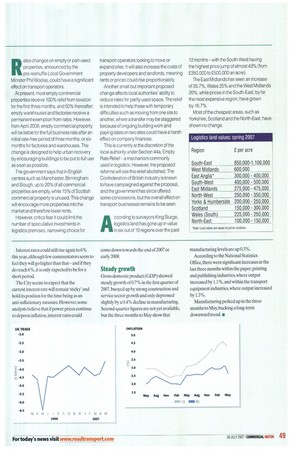money
Page 48

Page 49

If you've noticed an error in this article please click here to report it so we can fix it.
matters
Retail Price Index (RPI) inflation fell to 4.3% in May, down 0.2% from April, and Consumer Price Index (CPI) inflation fell 0.3% to 2.5%. RPIX inflation (API excluding mortgage interest payments) was also down 0.3%, to 3.3%.
The CPI and API were affected by similar factors, including downward pressure from the falling prices of gas, electricity, food, non-alcoholic beverages, clothing and footwear.
Upward pressure on both came from transport, with significant increases in the cost of air travel especially for transatlantic and Continental routes.
The CPI shows that the UK inflation rate is above the EU average.
UK exporters are holding their own despite the strong pound as early data suggests that the trade deficit has shrunk to its lowest level since October 2005.
The pound is still at full strength, trading at $2.02its highest level in 26 years. But the trade deficit in goods closed between April and May from £6.9bn to £6.3bn.Analysts say this is surprising but encouraging. However, exports will not be strong enough to sustain UK growth if high interest rates suppress domestic activity later in the year.
The deficit with the enlarged EU (27 countries including Bulgaria and Romania) narrowed to £2.8bn compared with £3.1bn in April. Exports rose by £400m and imports increased by £200m. Excluding oil and 'erratic items', the volume of exports rose 3.5% from April to May while the volume of imports fell by 0.5%.
Interesting times
The Bank of England has raised interest rates again, this time by 0.25%, to 5.75%. This is the fifth rate increase since last August; the previous change was an increase of 0.25% to 5.5% in May.
The Bank of England says output growth has remained firm and appears to be developing in line with the Monetary Policy Committee's most recent projections. It also believes that lower gas and electricity prices mean CPI inflation is likely to continue to fall back to about 2% this year. Rates changes on empty or part-used properties, announced by the pre-reshuffle Local Government Minister Phil Woolas, could have a significant effect on transport operators.
At present, most empty commercial properties receive 100% relief from taxation for the first three months, and 50% thereafter; empty warehouses and factories receive a permanent exemption from rates. However, from April 2008, empty commercial property will be liable for the full business rate after an Initial rate-free period of three months, or six months for factories and warehouses. The change is designed to help urban recovery by encouraging buildings to be put to full use as soon as possible.
The government says that in English centres such as Manchester, Birmingham and Slough, up to 20% of all commercial properties are empty, while 15% of Scottish commercial property is unused. This change will encourage more properties into the market and therefore lower rents.
However, critics fear it could limit the number of speculative investments in logistics premises, narrowing choice for Interest rates could still rise again to 6% this year, although few commentators seem to feel they will go higher than that and if they do reach 6%, it is only expected to be for a short period.
The City seems to expect that the current interest rate will remain 'sticky' and hold its position for the time being as an anti-inflationary measure. However, some analysts believe that if power prices continue to depress inflation, interest rates could transport operators looking to move or expand sites. It will also increase the costs of property developers and landlords, meaning rents or prices could rise proportionately.
Another small but important proposed change affects local authorities' ability to reduce rates for partly used space. The relief is intended to help those with temporary difficulties such as moving from one site to another, where a transfer may be staggered because of ongoing building work and paying rates on two sites could have a harsh effect on company finances.
This is currently at the discretion of the local authority under Section 44a, Empty Rate Reliefa mechanism commonly used in logistics. However, the proposed reforms will see this relief abolished. The Confederation of British Industry is known to have campaigned against the proposal, and the government has since offered some concessions, but the overall effect on transport businesses remains to be seen.
According to surveyors King Sturge, logistics land has gone up in value in six out of 10 regions over the past come down towards the end of 2007 or early 2008.
Steady growth
Gross domestic product (GDP) showed steady growth of 0.7% in the first quarter of 2007, buoyed up by strong construction and service sector growth and only depressed slightly by a 0.4% decline in manufacturing. Second-quarter figures are not yet available, but the three months to May show that 12 months -with the South-West having the highest price jump of almost 43% (from 2350,000 to E500,000 an acre).
The East Midlands has seen an increase of 35.7%, Wales 25% and the West Midlands 20%, while prices in the South-East, by far the most expensive region, have grown by 16.7%.
Most of the cheapest areas, such as Yorkshire, Scotland and the North-East, have shown no change.
manufacturing levels are up 0.3%.
According to the National Statistics Office, there were significant increases in the last three months within the paper, printing and publishing industries, where output increased by 1.1 %, and within the transport equipment industries, where output increased by 1.3%.
Manufacturing perked up in the three months to May, bucking a long-term downward trend. •
























































































































































































